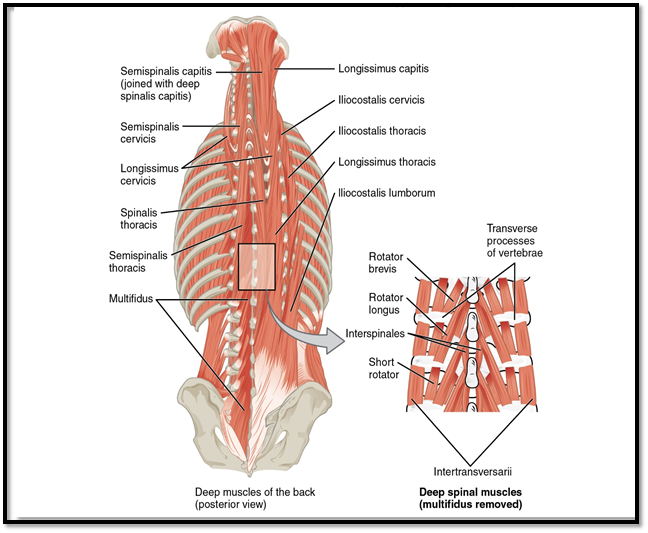Thorax
Muscles
Muscles of the thoracic spine is arranged in layers and these muscles and ligaments work together to support the spine, hold it upright, and control movement during rest and activity. The layers of the muscles are superficial and deep. Appendicular muscles that are on the thoracic spine region are trapezius, rhomboid major and rhomboid minor. Muscles that are important in the superficial layer is the erector spinae muscle. The Erector Spinae muscle actually consists of three columns of muscles, the Iliocostalis, Longissimus, and Spinalis, each running parallel on either outer side of the vertebra and extending from the lower back of the skull all the way down to the Pelvis. The Erector Spinae provides resistance that assists in the control action of bending forward at the waist as well as acting as powerful extensors to promote the return of the back to the erect position. During full flexion (i.e., when touching fingertips to floor), the erector spinae muscles are relaxed and strain is borne entirely by ligaments of the back. Muscles of the erector spinae that are interacting with the thoracic region are spinalis thoracis,longissimus thoracis, illiocastalis thoracis, semispinalis cervicis, semispinalis thoracis and semispinalis capitis.
Erector spinae muscles of the thoracic spine
| Muscle | Origin | Insertion | Action | Innervation |
| Spinalis thoracis | Spinous processes of inferior thoracic and superior lumbar vertebrae | Spinous processes of superior thoracic vertebrae | Extend vertebral column | Thoracic and lumbar spinal nerves |
| Longissimus cervicis | Transverse processes of superior thoracic vertebrae | Transverse processes of middle and superior cervical vertebrae | Together, the two sides extend head; alone, each rotates and laterally flexes neck to that side | Cervical and thoracic spinal nerves |
| Longissimus thoracis | Broad aponeurosis and transverse processes of inferior thoracic and superior lumbar vertebrae | Transverse processes of superior vertebrae and inferior surfaces of ribs | Extends vertebral column; alone, each produces lateral flexion to the side | Thoracic and lumbar spinal nerves |
| Illiocastalis thoracis | Superior borders of inferior seven ribs medial to the angles | Upper ribs and transverse process of last cervical vertebrae | Stabilizes thoracic vertebrae in extension | Thoracic spinal nerves |
| Semispinalis thoracis | Transverse processes of T6- T10 | Spinous processes of C5-T4 | Extends vertebral column and rotates toward opposite side | Thoracic spinal nerves |


